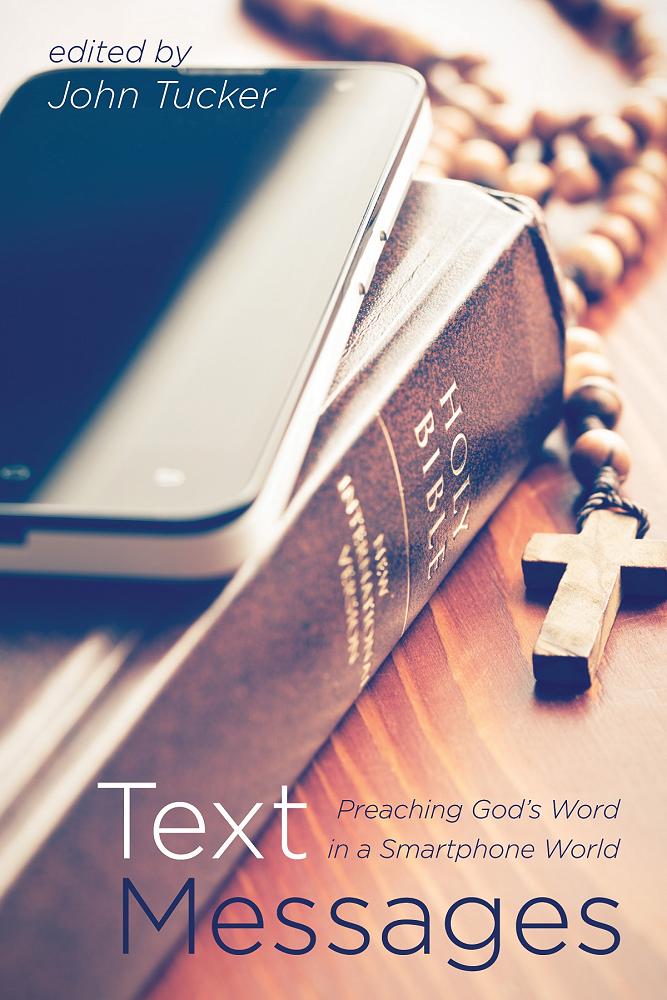
Book Review: Text Messages: Preaching God's Word in a Smartphone World
John Tucker, Editor.
The premise behind this book is that there is a “crisis in preaching”, brought about in part by the communications revolution: the triumph of images over words, social media’s preference for dialogue rather than monologue, listeners’ expecting to be entertained, and scepticism about authoritative pronouncements. Hence the subtitle: Preaching God’s Word in a Smartphone World. I have to admit that I am not convinced about the “crisis.” Yes, we are more distracted these days, but there is still a place for the regular articulation of the gospel, the speaking of Scripture into the lives of a group of people.
The book is structured around the five elements of preaching laid out in Paul Windsor’s opening essay “What is Preaching?: Text, Society, Listener, Preacher, and Christ.” I read each contribution with two questions in mind: will this make me a better preacher? And would this be useful for the novice preachers I help to train? Incidentally, Windsor’s comment on “preaching worldviewishly” (10) to allow the gospel to subvert and convert in our context has stayed with me.
I found the idea in Darrell Johnson’s “The Transforming Power of Text: Seven Discoveries” that any given text is describing a particular dimension of a larger alternative reality, a room, or space within the whole of reality, and that “the task of preaching is to help people enter the room” (38) to be an intriguing and helpful one, prioritising helping people get into the text over getting a message out of the text.
Geoff New’s “Lost for Words: How to Read Scripture in a Smartphone World” is one of the surprisingly few chapters to grapple explicitly with the book’s subtitle and I did not find it particularly successful. He is good on the culture of distraction and the way that the internet has changed the way we read, but where I part company with him is in his concern that we risk dehumanising our experience of and engagement with Scripture “by reducing it to a technological experience and mediating it by virtue of a machine” (56). Tell that to the woman in her eighties I know who is able to read her Bible much more since she installed the YouVersion app on her IPad! The section on Text is rounded out by Andrea McDougall on “Karl Barth’s Theology of Preaching”. I appreciated Barth’s reminder of the importance of prayer, and that preaching is both a human and a divine work, but the bit that spoke to me most is where she shared her experience of applying Barth’s practice of crafting prayers to begin and end sermons to her own preaching.
What stood out in Robert Smith’s contribution to the Society section, “The Fundamentals of Cross-Cultural Preaching” was his comment that for preachers to “start and remain intentionally within one’s own culture is to violate the Great Commission” (102). He draws out some implications of this for Aotearoa New Zealand, with its increasingly diverse population. I found Marc Rader’s “Looking Backward to Look Forward: Insights from the Past for Preaching to the Future” frustrating. His survey of preaching over past centuries was interesting, but his main insight that “the pulpit is reactive to, and reflective of, its context” seemed rather obvious. I would have liked more of his “looking forward” and a greater development of his final speculations on the future of preaching.
I was disappointed by Simon Moetara’s essay “Preaching with Vulnerability: Self-disclosure in the Pulpit:” when and how much to reveal of one’s own story is something that all new preachers need to learn, and I was looking for insights to help me guide those I am working with. Yes, it is clear that self-disclosure can assist others to open up, but surely it is possible to make this useful point without going down the track of “here is a way of modelling a different masculinity” and “providing an important corrective to Pentecostal-Charismatic attitudes towards suffering.” There were fewer insights here for preachers (like me) who are not male or Pentecostal.
The Listener section opened with Laurie Guy’s “Engaging the Listener: Passionate, Pointed, and Prophetic Preaching.” Here I was challenged by his reminder that the preacher’s task is not simply to inform and inspire but actually to transform, to bring change in those who are listening (138). Scary question to self: how has my preaching changed my congregations? Jody Kilpatrick takes another tack, exploring how the “open mike” tradition in her parish has developed the congregation’s ability to listen to the voice of God in their midst in “Free-for-all: How a Culture of Giving Voice Shapes Preaching.” Here I must admit to being intrigued but not totally convinced: I like the idea of helping people see that there are many ways of reading a text, but I am wary of the dangers and limitations of the practice which she outlines.
I appreciated Lynne Baab’s contribution to the section on Preacher, “Spiritual Practices for Preachers: Making Space for a Continuing Conversation with the Living God.” She offers a number of spiritual disciplines that train us in faithfulness and create spaces for us to “keep company” with Jesus, arranged in categories of Bible, prayer, and “other” (e.g. Sabbath-keeping). Everyone should engage in these, she says, but for preachers and others in ministry she recommends having at least one spiritual practice in each category that has nothing to do with ministry (170). This is wise: I suspect all preachers occasionally fall into the trap of having most of their Bible-reading aimed at the next sermon. John Tucker’s essay “Upgrading Our Preaching: Professional Development for Preachers Today” can perhaps be summed by the comment “It takes a village to raise a preacher” (202). He advocates input from role models, mentors, peers, and congregations in developing preachers. Philip Halstead’s piece “Depleted No More: Practices that Sustain and Invigorate Preaching Ministries” is much less successful. This is mainly because he equates preaching with pastoring, and much of what he says (about avoiding burnout for example) relates to parish ministry as a whole, rather than to the preaching task. I’m not sure that this chapter belongs in this book.
The editor saved the best until last. The section on Christ has two stunning chapters: Mark Keown’s “Preaching Christ Crucified: Cruciformity in Content and Delivery” and William Willimon’s “Disturbed Words: The Holy Spirit and Preaching.” Keown explores Paul’s preaching to the Corinthians, in which he steered away from flashy techniques which obscured the message, and challenges preachers today to do the same with a series of searching questions about our delivery. These are what will stay with me into the future. Willimon’s description of how the Holy Spirit “rips the sermon out of my hands and says more that I meant’” (230) resonates with me. I am delighted too with his closing comment that “after decades I’m still invigorated by the homiletical task” (239). May this be true for all of us!
Deborah Broome is Ministry Educator in the Anglican Diocese of Waiapu.
